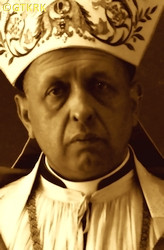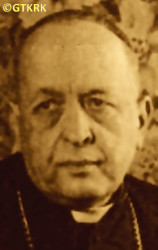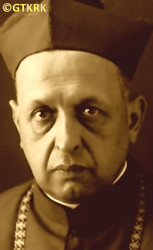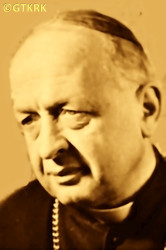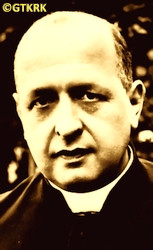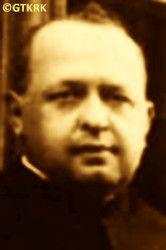Roman Catholic
St Sigismund parish
05-507 Słomczyn
85 Wiślana Str.
Konstancin deanery
Warsaw archdiocese, Poland
full list:
displayClick to display full list

searchClick to search full list by categories
wyświetlKliknij by wyświetlić pełną listę po polsku

szukajKliknij by przeszukać listę wg kategorii po polsku

Martyrology of the clergy — Poland
XX century (1914 – 1989)
personal data
surname
BUKRABA
forename(s)
Casimir (pl. Kazimierz)

function
bishop
creed
Latin (Roman Catholic) Church RCmore on
en.wikipedia.org
[access: 2014.09.21]
diocese / province
Pinsk diocesemore on
en.wikipedia.org
[access: 2013.05.19]
Minsk diocesemore on
en.wikipedia.org
[access: 2013.05.19]
Mogilev archdiocesemore on
en.wikipedia.org
[access: 2013.06.23]
date and place
of death
07.05.1946

Łódźtoday: Łódź city pov., Łódź voiv., Poland
more on
en.wikipedia.org
[access: 2021.07.18]
details of death
During World War I, 1914‐1918 s Polish independence activist.
After the Russian defeat in the Battle of Gorlice in 05.1915 and the end of the Russian occupation in most of the pre–partition Polish territories, after the start of the German occupation, several times held hostage by the Germans in the case of Jews accused of spying for the Russian Bolsheviks.
Successfully intervened numerous times in their defense before the German military field court.
After the German and Russian invasion of Poland in 09.1939 and the start of World War II, after the start of the Russian occupation, forced on 15.11.1939 to leave the diocese — partly due to heart disease and nervous depression — and start treatment at the university clinic in Lviv.
After the German attack on 22.06.1941 on their former ally, the Russians, and the start of the German occupation, moved on 12.02.1942 to Warsaw (Lviv was annexed into the German‐run Germ. Generalgouvernement (Eng. General Governorate) of which Warsaw was a part of).
There attempted to obtain permission from the Germans to return to his diocese — the consent was necessary because his diocese found itself divided in three different administrative units created by the Germans: the main part with the cathedral Pinsk in the Germ. Reichskommissariat Ukraine (Eng. Reich's Commissariat Ukraine), part in Germ. Reichskommissariat Ostland (Eng. Reich's Commissariat East), and part in Germ. Bezirk Bialystok (Eng. Białystok District), directly attached to Germ. Provinz Ostpreußen (Eng. Province of East Prussia).
Unsuccessfully.
In 08‐10.1944, took part as a chaplain of the pro–independence, clandestine Home Army AK (part of Polish Clandestine State) in the Warsaw Uprising.
After its capitulation on 02.10.1944, together with thousands of Varsovians, herded to the German transit camp DL 121 Pruszków.
From there made his way to Milanówek.
In 01.1945, after the German defeat and the beginning of another Russian occupation, settled in Łódź, in the house of the Ursulines.
There soon died — suffered a cerebral hemorrhage and paralysis of the left side of his body.
cause of death
deportation
perpetrators
Germans / Russians
sites and events
DL 121 PruszkówClick to display the description, Greater Poland UprisingClick to display the description, GeneralgouvernementClick to display the description, Ribbentrop‐MolotovClick to display the description, Pius XI's encyclicalsClick to display the description
date and place
of birth
05.12.1885Birth certification on:
www.familysearch.org
[access: 2025.09.22]

Grodnotoday: Grodno dist., Grodno reg., Belarus
more on
en.wikipedia.org
[access: 2023.01.18]
alt. dates and places
of birth
23.11.1885
(Julian calendar)
parents
BUKRABA Casimir
🞲 ?, ? — 🕆 ?, ?

CYREWICZ Sophia
🞲 ?, ? — 🕆 ?, ?
baptism
13.12.1885Birth certification on:
www.familysearch.org
[access: 2025.09.22]

Grodnotoday: Grodno dist., Grodno reg., Belarus
more on
en.wikipedia.org
[access: 2023.01.18]
Exaltation of the Holy Cross RC church (post—Bernardine)
presbyter (holy orders)
ordination
02.02.1909

KrakówStare Miasto (Old Town) district
today: Kraków city pov., Lesser Poland voiv., Poland
more on
en.wikipedia.org
[access: 2021.12.18]
St Michael the Archangel and St Stanislav the Bishop and Martyr RC churchmore on
en.wikipedia.org
[access: 2023.01.13] („on the Rock”)
positions held
1932 – 1946
bishop — Pinsk RC diocese — appointment: 10.07.1932; ordained: 21.08.1932, St Casimir church in Vilnius; also: member of the Unionist Commission of the Polish Episcopate
1928 – 1932
dean — Brest on Bugform.: Brest‐Litovsk /till 1923/
today: Brest, Brest dist., Brest reg., Belarus
more on
en.wikipedia.org
[access: 2021.09.29] RC deanery
1928 – 1932
parish priest — Brest on Bugform.: Brest‐Litovsk /till 1923/
today: Brest, Brest dist., Brest reg., Belarus
more on
en.wikipedia.org
[access: 2021.09.29] ⋄ Exaltation of the Holy Cross RC parish ⋄ Brest on Bugform.: Brest‐Litovsk /till 1923/
today: Brest, Brest dist., Brest reg., Belarus
more on
en.wikipedia.org
[access: 2021.09.29] RC deanery
1919 – 1928
dean — Navahrudaktoday: Navahrudak dist., Grodno reg., Belarus
more on
en.wikipedia.org
[access: 2021.07.04] RC deanery
1919 – 1928
parish priest — Navahrudaktoday: Navahrudak dist., Grodno reg., Belarus
more on
en.wikipedia.org
[access: 2021.07.04] ⋄ Transfiguration of the Lord RC parish ⋄ Navahrudaktoday: Navahrudak dist., Grodno reg., Belarus
more on
en.wikipedia.org
[access: 2021.07.04] RC deanery
1912 – 1919
curatus/rector/expositus — Pinsktoday: Pinsk city dist., Brest reg., Belarus
more on
en.wikipedia.org
[access: 2022.07.16] ⋄ St Charles Borromeo RC church ⋄ Assumption of the Blessed Virgin Mary RC parish ⋄ Pinsktoday: Pinsk city dist., Brest reg., Belarus
more on
en.wikipedia.org
[access: 2022.07.16] RC deanery — from c. 1915 de facto acting („ad interim”) parish administrator; also: prefect of schools: real, gymnasium for girls, progymnasium and two elementary schools
1909 – 1912
vicar — Minsktoday: Minsk city reg., Belarus
more on
en.wikipedia.org
[access: 2020.07.31] ⋄ Holy Name of Blessed Virgin Mary RC cathedral parish ⋄ Minsktoday: Minsk city reg., Belarus
more on
en.wikipedia.org
[access: 2020.07.31] RC deanery — also: prefect of secondary schools
1908 – 1909
student — Innsbrucktoday: Innsbruck‐Land dist., Tyrol state, Austria
more on
en.wikipedia.org
[access: 2024.03.19] ⋄ philosophy and theology, Leopold and Francis University
1904 – 1908
student — Sankt Petersburgtoday: Saint Petersburg city, Russia
more on
en.wikipedia.org
[access: 2020.07.31] ⋄ philosophy and theology, Metropolitan Theological Seminary
sites and events
descriptions
DL 121 Pruszków: Germ. Durchgangslager 121 Pruszków (Eng. Transit Camp) — transit camp where Germans herded Warsaw (and its vicinity) civilian population captured during and after Warsaw Uprising. Set up on 06.01.1944 functioned till 12.1944. C. 390,000‐410,000 people were held captive. Most of them were sent subsequently to concentration camps and forced slave labour in Germany. Few hundred ‐ few thousands of them perished in the camp. (more on: pl.wikipedia.orgClick to attempt to display webpage
[access: 2015.03.01])
Greater Poland Uprising: Military insurrection of Poles of former German Germ. Posen Provinz (Eng. Poznań province) launched against German Reich in 1918‐1919 — after the abdication on 09.11.1918 of the German Emperor William II Hohenzollern; after the armistice between the Allies and Germany signed on 11.1.1918 in the HQ wagon in Compiègne, the headquarters of Marshal of France Ferdinand Foch — which de facto meant the end of World War I — against the German Weimar Republic, established on the ruins of the German Empire, aiming to incorporate lands captured by Prussia during partitions of Poland in XVIII century into Poland. The Republic of Poland, reborn on 11.11.1918, initially formally included only the so‐called Germ. Königreich Polen (Eng. Kingdom of Poland), i.e. the territory that had been under Russian rule until 1915 and then under the control of Central States (Germany and Austria–Hungary), but did not include the Prussian partition. Started on 27.12.1918 in Poznań and ended on 16.02.1919 with the armistice pact in Trier, forced by the victorious Entente states, which included provisions ordering Germany to cease operations against Poland and, importantly, recognizing the Polish insurgent Greater Poland Army as an allied armed force of the Entente. De facto it turned out to be a Polish victory, confirmed in the main peace treaty after World War I, the Treaty of Versailles of 28.06.1919, which came into force on 10.01.1920 and in which most of the lands of the Prussian partition were recognized as Polish. Many Polish priests took part in the Uprising, both as chaplains of the insurgents units and members and leaders of the Polish agencies and councils set up in the areas covered by the Uprising. In 1939 after German invasion of Poland and start of the World War II those priests were particularly persecuted by the Germans and majority of them were murdered. (more on: en.wikipedia.orgClick to attempt to display webpage
[access: 2016.08.14])
Generalgouvernement: After the Polish defeat in the 09.1939 campaign, which was the result of the Ribbentrop‐Molotov Pact and constituted the first stage of World War II, and the beginning of German occupation in part of Poland (in the other, eastern part of Poland, the Russian occupation began), the Germans divided the occupied Polish territory into five main regions. In two of them new German provinces were created, two other were incorporated into other provinces. However, the fifth part was treated separately, and in a political sense it was supposed to recreate the German idea from 1915 (during World War I, after the defeat of the Russians in the Battle of Gorlice in 05.1915) of creating a Polish enclave within Germany. Illegal in the sense of international law, i.e. Hague Convention, and public law, managed by the Germans according to separate laws — especially established for the Polish Germ. Untermenschen (Eng. subhumans) — till the Russian offensive in 1945 it constituted part of the Germ. Großdeutschland (Eng. Greater Germany). Till 31.07.1940 formally called Germ. Generalgouvernement für die besetzten polnischen Gebiete (Eng. General Government for the occupied Polish lands) — later simply Germ. Generalgouvernement (Eng. General Governorate), as in the years 1915‐1918. From 07.1941, i.e. after the German attack on 22.06.1941 against the erstwhile ally, the Russians, it also included the Galicia district, i.e. the Polish pre‐war south‐eastern voivodeships. A special criminal law was enacted and applied to Poles and Jews, allowing for the arbitrary administration of the death penalty regardless of the age of the „perpetrator”, and sanctioning the use of collective responsibility. After the end of the military conflict of the World War UU, the government of the Germ. Generalgouvernement was recognized as a criminal organization, and its leader, governor Hans Frank, guilty of war crimes and crimes against humanity and executed. (more on: en.wikipedia.orgClick to attempt to display webpage
[access: 2024.12.13])
Ribbentrop‐Molotov: Genocidal Russian‐German alliance pact between Russian leader Joseph Stalin and German leader Adolf Hitler signed on 23.08.1939 in Moscow by respective foreign ministers, Mr. Vyacheslav Molotov for Russia and Joachim von Ribbentrop for Germany. The pact sanctioned and was the direct cause of joint Russian and German invasion of Poland and the outbreak of the World War II in 09.1939. In a political sense, the pact was an attempt to restore the status quo ante before 1914, with one exception, namely the „commercial” exchange of the so‐called „Kingdom of Poland”, which in 1914 was part of the Russian Empire, fore Eastern Galicia (today's western Ukraine), in 1914 belonging to the Austro‐Hungarian Empire. Galicia, including Lviv, was to be taken over by the Russians, the „Kingdom of Poland” — under the name of the General Governorate — Germany. The resultant „war was one of the greatest calamities and dramas of humanity in history, for two atheistic and anti‐Christian ideologies — national and international socialism — rejected God and His fifth Decalogue commandment: Thou shall not kill!” (Abp Stanislav Gądecki, 01.09.2019). The decisions taken — backed up by the betrayal of the formal allies of Poland, France and Germany, which on 12.09.1939, at a joint conference in Abbeville, decided not to provide aid to attacked Poland and not to take military action against Germany (a clear breach of treaty obligations with Poland) — were on 28.09.1939 slightly altered and made more precise when a treaty on „German‐Russian boundaries and friendship” was agreed by the same murderous signatories. One of its findings was establishment of spheres of influence in Central and Eastern Europe and in consequence IV partition of Poland. In one of its secret annexes agreed, that: „the Signatories will not tolerate on its respective territories any Polish propaganda that affects the territory of the other Side. On their respective territories they will suppress all such propaganda and inform each other of the measures taken to accomplish it”. The agreements resulted in a series of meeting between two genocidal organization representing both sides — German Gestapo and Russian NKVD when coordination of efforts to exterminate Polish intelligentsia and Polish leading classes (in Germany called «Intelligenzaktion», in Russia took the form of Katyń massacres) where discussed. Resulted in deaths of hundreds of thousands of Polish intelligentsia, including thousands of priests presented here, and tens of millions of ordinary people,. The results of this Russian‐German pact lasted till 1989 and are still in evidence even today. (more on: en.wikipedia.orgClick to attempt to display webpage
[access: 2015.09.30])
Pius XI's encyclicals: Facing the creation of two totalitarian systems in Europe, which seemed to compete with each other, though there were more similarities than contradictions between them, Pope Pius XI issued in 03.1937 (within 5 days) two encyclicals. In the „Mit brennender Sorge” (Eng. „With Burning Concern”) published on 14.03.1938, condemned the national socialism prevailing in Germany. The Pope wrote: „Whoever, following the old Germanic‐pre‐Christian beliefs, puts various impersonal fate in the place of a personal God, denies the wisdom of God and Providence […], whoever exalts earthly values: race or nation, or state, or state system, representatives of state power or other fundamental values of human society, […] and makes them the highest standard of all values, including religious ones, and idolizes them, this one […] is far from true faith in God and from a worldview corresponding to such faith”. On 19.03.1937, published „Divini Redemptoris” (Eng. „Divine Redeemer”), in which criticized Russian communism, dialectical materialism and the class struggle theory. The Pope wrote: „Communism deprives man of freedom, and therefore the spiritual basis of all life norms. It deprives the human person of all his dignity and any moral support with which he could resist the onslaught of blind passions […] This is the new gospel that Bolshevik and godless communism preaches as a message of salvation and redemption of humanity”… Pius XI demanded that the established human law be subjected to the natural law of God , recommended the implementation of the ideal of a Christian state and society, and called on Catholics to resist. Two years later, National Socialist Germany and Communist Russia came together and started World War II. (more on: www.vatican.vaClick to attempt to display webpage
[access: 2023.05.28], www.vatican.vaClick to attempt to display webpage
[access: 2023.05.28])
sources
personal:
pl.wikipedia.orgClick to attempt to display webpage
[access: 2023.01.13], www.naszaprzeszlosc.plClick to attempt to display webpage
[access: 2023.01.13], www.familysearch.orgClick to attempt to display webpage
[access: 2025.09.22]
original images:
audiovis.nac.gov.plClick to attempt to display webpage
[access: 2023.01.13], www.naszaprzeszlosc.plClick to attempt to display webpage
[access: 2023.01.13], audiovis.nac.gov.plClick to attempt to display webpage
[access: 2023.01.13], polesie.orgClick to attempt to display webpage
[access: 2023.01.13], commons.wikimedia.orgClick to attempt to display webpage
[access: 2023.01.13], polesie.orgClick to attempt to display webpage
[access: 2023.01.13]
LETTER to CUSTODIAN/ADMINISTRATOR
If you have an Email client on your communicator/computer — such as Mozilla Thunderbird, Windows Mail or Microsoft Outlook, described at WikipediaPatrz:
en.wikipedia.org, among others — try the link below, please:
LETTER to CUSTODIAN/ADMINISTRATORClick and try to call your own Email client
If however you do not run such a client or the above link is not active please send an email to the Custodian/Administrator using your account — in your customary email/correspondence engine — at the following address:

giving the following as the subject:
MARTYROLOGY: BUKRABA Casimir
To return to the biography press below:
 Click to return to biography
Click to return to biography








